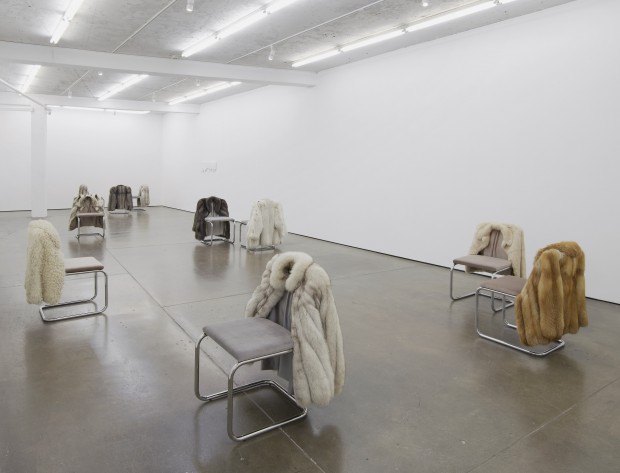Here are some fur coats reclaiming the design canon for the sisterhood. They are draped over the back of tubular steel chairs. In this daring arrangement, they subvert the established patriarchy by partially obscuring the ‘autograph design object’ of the chair, something that represents the historic subsuming of all female creativity under male dominance.
While this will be obvious enough, it must be appreciated in the greater context of the work which ‘extrudes novelty from recognisability via subtle acts of transformation’ and in doing so ‘displaces the certainty with which we appoint function and value to objects’. I read this in the catalogue, an essential companion to Nicole Wermers’ ‘Untitled Chairs’. Here, curator Paul Pieroni shows himself to be a master of his under-appreciated medium. It is tempting to quote at length. If the Turner was awarded for nonsense prose, and sometimes you’d be forgiven for thinking it might as well be, Pieroni would be a shoo-in. I admire his work, or, as he would no doubt say, his practice. The problem with the actual artwork is that it’s just so boring. It is dull to look at and the concepts behind it are fatuous.
Janice Kerbel has been nominated for something called ‘DOUG’. When I visited the exhibition ‘DOUG’ was not there. On the wall were the words that ‘DOUG’ would offer when present in nine songs signifying an ‘imagined disaster’. One of the disasters appears to be slipping on a banana skin:
‘Heel on peel
To seal the deal
Feet to sky
Life slips by’
The songs are sung by six voices and the composition cleverly mimics the verse, apparently. Undoubtedly extraordinary to hear, but the exhibit was having its lunch when I visited.
If you went to university, you probably met someone who lurked in his room, smoking skunk and reading science fiction and psychology books. By the end of first year, he would have developed a paranoia complex precipitated by a sudden realisation that literally everything was profoundly connected and that all aspects of modern life were but a manifestation of the will of obscure overlords to subdue and control us. If you had the misfortune to go to art school, this idiot would have been considered a genius in front of whom first year girls would prostate themselves at the first flash of The Tibetan Book of the Dead. His four-hour degree-show video of abstract TV-to-camera feedback patterns would have been awarded a first.
Bonnie Camplin’s Turner exhibit, ‘The Military Industrial Complex’, is basically that guy’s mind laid out. Surprisingly, it is a compelling portrait. The catalogue notes are again by Pieroni so best to bypass them and absorb yourself in the videos, interviews with people who have had extraordinary experiences, and examine the tables of literature. From a worryingly curator-friendly starting point, Camplin has created something intriguing and pleasingly open to interpretation.
The best thing in the Turner show is the work by the group Assemble which is not an artwork at all but a real-life social enterprise. They collaborate with local communities on regenerative projects and the focus of their nomination is Granby Four Streets in Liverpool. Here they have been engaged in efforts to reclaim abandoned terraces through craft and design. How they came to be nominated for the Turner is baffling but the group have taken the opportunity thrust their way and created a wonderful enterprise out of it that will benefit that community. Real, handmade objects made by the Granby Workshop are on display here and all for sale. It is very old fashioned and the whole thing is refreshingly positive, genuine and ego-free. They’ll never win.






Comments